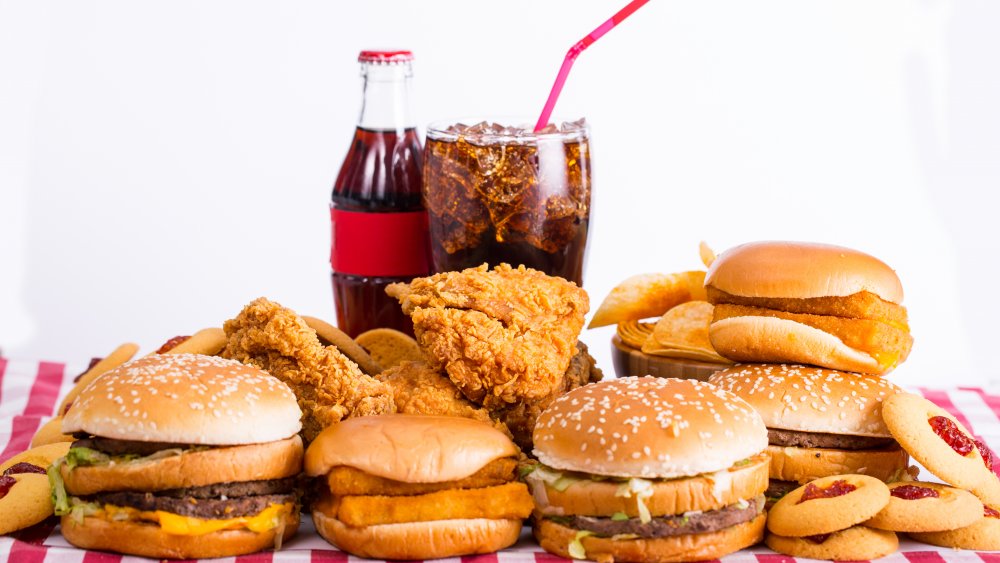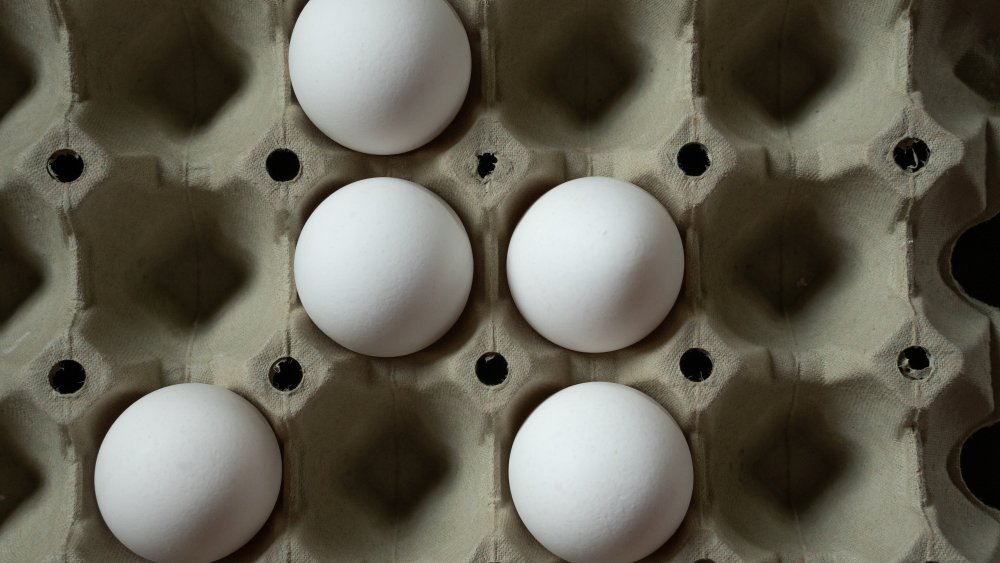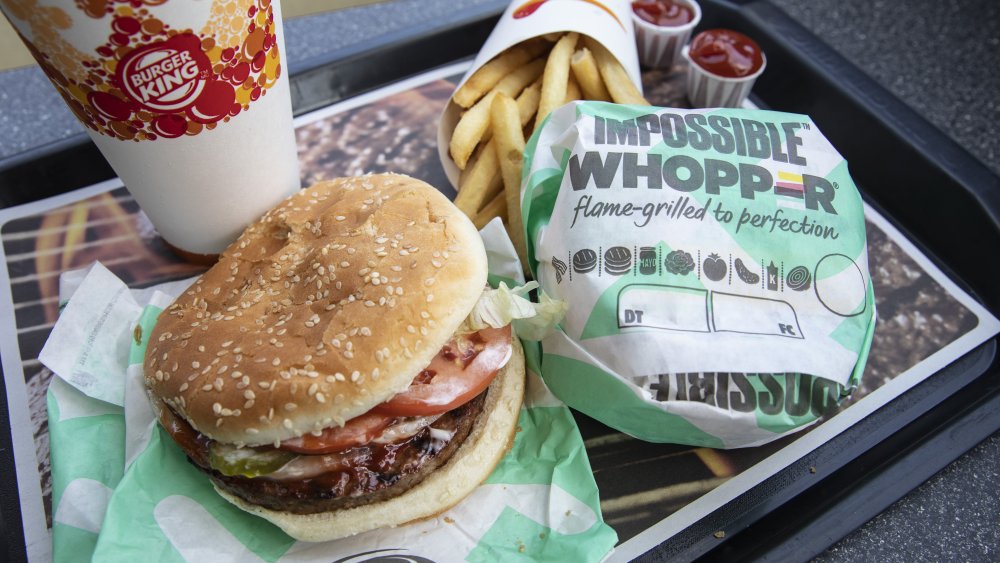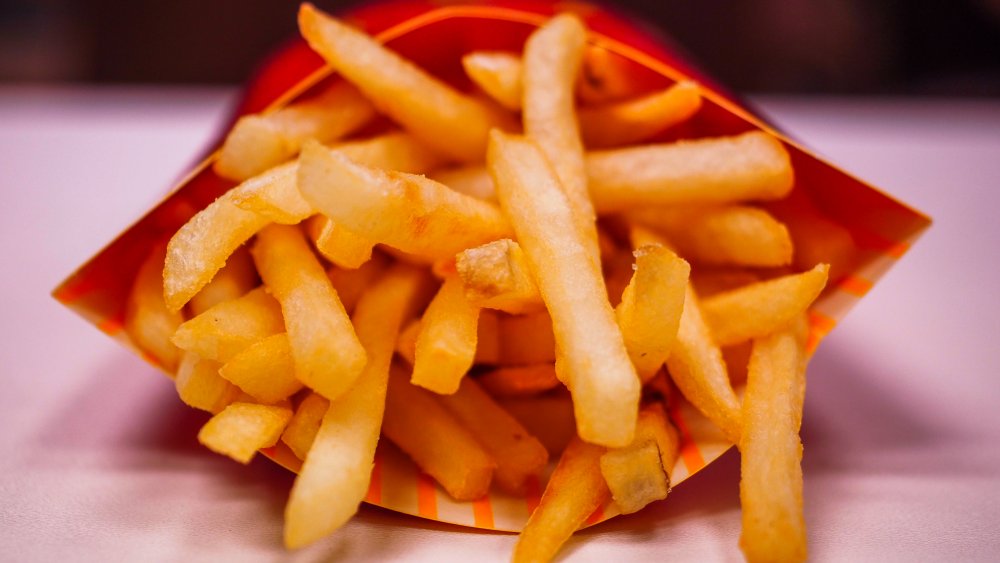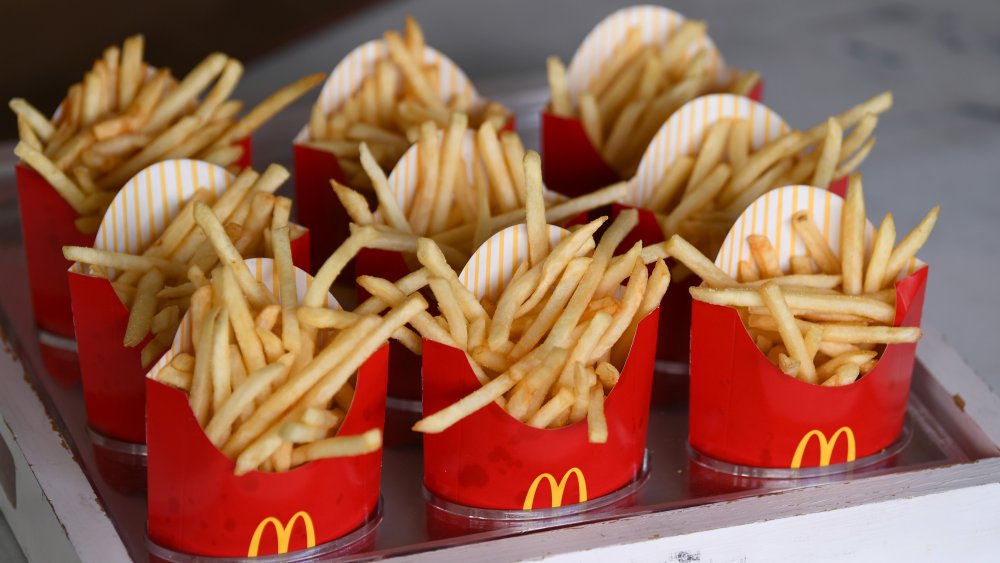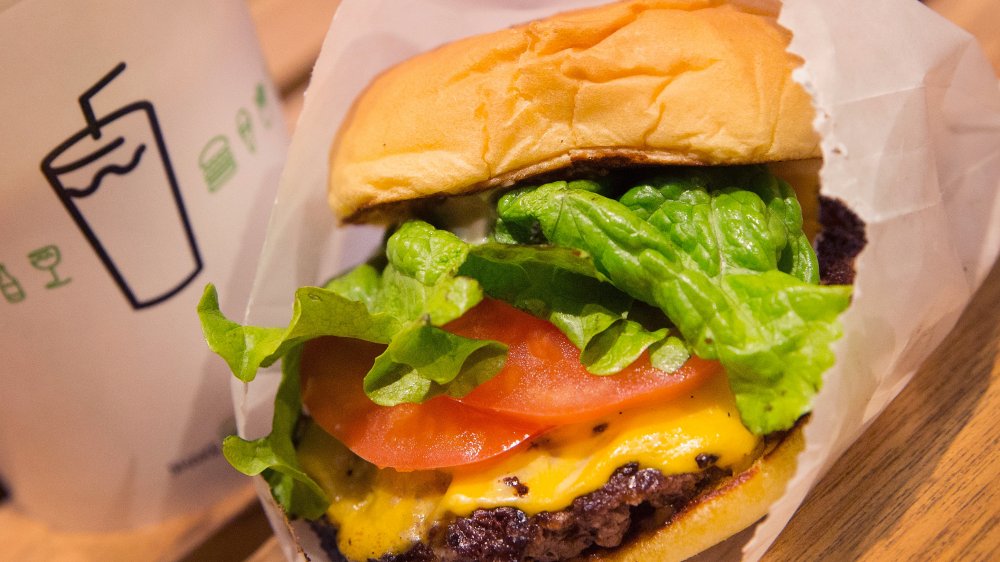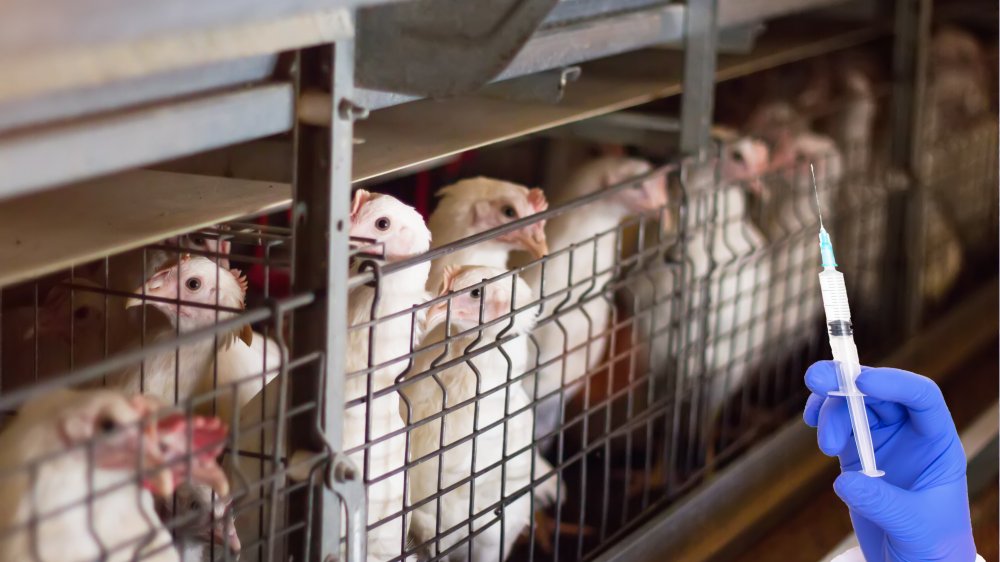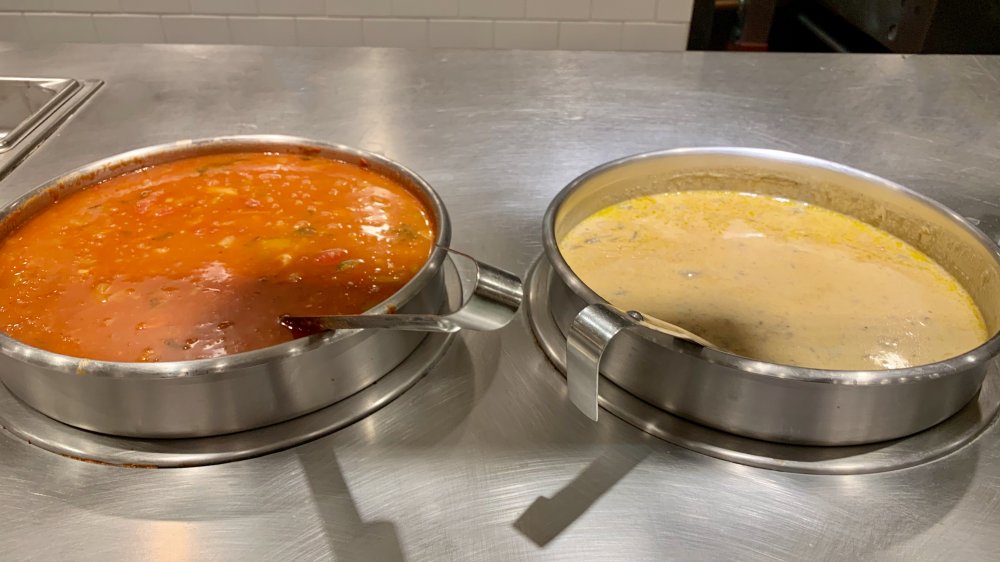Shady Things Revealed About Fast Food In The Past Decade
What a decade the 2010s was, especially for foodies.
Between the rise and fall of rainbow foods, the invention of crazy pastries like the cronut, and so much more, this decade has been a doozy when it comes to food. But at the same time, among all of the incredible foods on the rise, there's been a few things revealed along the way that weren't so savory — much of it having to do with fast food.
According to a 2018 report from the U.S. Centers for Disease Control and Prevention (via CNN), almost 85 million adults eat fast food each day. And while consumers have been heading through the drive-thru for their favorite fries and double-cheeseburger, or their grabbing breakfast on-the-go, they may not have known exactly what they were consuming.
There have been a few secrets lurking in fast food joints, many of which came to light during the last ten years, and we decided to recap them to reflect on all of the crazy things we have learned. Here are the shady things revealed about fast food in the past decade.
Most fast food eggs are made of more than just eggs
When you're on the run in the morning, grabbing a quick bite is all you have time to think about, certainly not the ingredients list of that breakfast sandwich. But in 2012, a contributor for Forbes decided to look into those popular sandwiches a bit more. As it turns out, the entire time we've been thinking our eggs from fast food joints were just plain old eggs, we've been eating sandwiches chock full of chemicals and preservatives.
Forbes revealed that the eggs Subway serves for breakfast contained glycerin, propylene glycol, and even calcium silicate. Yum! Subway's ingredients were perhaps the most shocking, but McDonald's ingredient list included a slew of preservatives, along with cottonseed oil and vegetable oil.
McDonald's has shortened their ingredients list slightly over the past decade, but Subway made much larger strides, taking out the delightful additives like glycerin and propylene glycol that used to grace their ingredients list.
Still, we all think a little differently about fast food eggs after what we learned this past decade.
Soda foundations aren't really all that clean
The fast food industry really started the twenty-tens out on a high note with this one, as the news came out that soda fountains may actuallygrow bacteria and house trace amounts of fecal contamination.
In 2010, ABC reported on a small study that found, of the 30 samples dispersed from soda machines that were tested, about 70 percent of them were accompanied by bacteria. Worse, 48 percent had coliform bacteria, indicating the possibility of fecal contamination.
Renee D. Godard, who published the study in the International Journal of Food Microbiology, found everything from coliform to E. coli, along with Staphylococcus in the samples.
Godard told ABC her hypothesis was that the tubing in the actual soda machines had something to do with it, with bacteria entering through the nozzles. "Our best guess is they're actually establishing themselves on the lining of the plastic tubing. The reason we say that is in other areas, such as hospitals, it is known that bacteria can establish themselves on plastic tubing for machines," said Godard.
Much of the reasoning was due to not rinsing the machines regularly enough. We sure hope management has figured out the trick to doing that more often.
Burger King's meat-free patties aren't totally meat-free
The past decade was definitely a time for the meatless burger to come of age. Sure, veggie burgers had been around a while, but the surge in the meatless trend didn't reach its full potential until restaurants started adding the option to their menus. And of course, fast food chains followed suit.
In 2019 Burger King announced the introduction of its Impossible Whopper, featuring a meatless burger, and people went crazy. Some even went as far as to say the Impossible Whopper was better than its original counterpart.
But not long after it launched, Burger King revealed the meatless option was being cooked on the same grill as its chicken and beef products. And while Burger King was upfront about their cooking process from the very beginning, vegans and vegetarians who missed the memo weren't too happy. One even went as far as suing Burger King for its alleged deception in advertising.
McDonald's fries contain a lot more than potatoes
People eat a lot of McDonald's french fries. Truly, an unimaginable amount. McDonald's stores go through almost 9 million pounds of fries around the world each day, so obviously there's something that keeps people coming back over and over. But the chemicals used during the production process probably aren't a part of that equation.
In the age of food transparency, McDonald's debuted a video in 2015 sharing exactly how their infamous fries are made. The video walks viewers through the process from the peeling and cutting, but perhaps the most alarming part was the bath the fries take before continuing down the line.
The company revealed that the cut potatoes are bathed in dextrose and sodium acid pyrophosphate. In an interview regarding the video, registered dietitian Georgie Fear told ABC that the dextrose is used to keep the fries looking uniformly golden, while the sodium acid pyrophosphate keeps them from turning gray once cooked. And while these chemicals have been approved for use, this info made a lot of people look at McDonald's fries in a whole new light.
You may not be getting a full order of fries
What if every time you ordered something from a fast food restaurant, you found out you weren't getting exactly the amount expected in the size ordered? Not filling a soda or a Wendy's Frosty all the way to the top before topping it with a lid may be disappointing, but being shorted on your favorite french fries? Heresy.
A Reddit thread started in 2017 asking about things that Redditors' jobs hid from their customers, revealed that McDonald's may have been intentionally stiffing their customers on fries.
One former McDonald's employee stated that he was taught "how to pinch the fry carton just right while putting the fries into them so that it looked full, but it actually wasn't." Another employee chimed in saying they hated that practice and refused to partake.
A McDonald's spokesperson denied the claims, telling HuffPost that there are procedures in place for adequate filling of fry containers. But HuffPost hypothesized that the claims may have been referring to standards set by a franchisee.
After this past decade, few of us trust that our fries are really full without a good shake.
Your fast food comes with a side of chemicals
Fast food can definitely get a bad rap when it comes to nutrition, from the high calorie and fat counts to the ridiculous amounts of sugar. There's also plenty of discussion about the actual food ingredients in fast food items, but one 2018 study revealed an item found in fast food that probably shouldn't be consumed at all.
A study published by Environmental Health Perspectives revealed the results of research conducted to assess urine samples of subjects who had consumed fast food in the previous 24 hours. The test was looking for phthalates, a potentially hazardous chemical, and samples revealed more phthalates found in the urine of subjects who ate more fast food.
According to the FDA, phthalates may be used in items like detergents, lubricants, wall coverings, and food packaging. According to the CDC, these chemicals may be used to make plastics more pliable and more difficult to break. But, there have also been findings that link the chemicals to the disruption of hormones, along with birth defects and child behavioral issues.
The levels discovered were trace amounts, and weren't measured in any foods, but the chemicals were present nonetheless. Just another reason we had to be wary of fast food this past decade.
Pizza boxes come with chemicals, but they were banned
The past decade was a long stream of discoveries about chemicals related to fast food, and this discovery was potentially one of the most important.
The U.S. Food and Drug Administration completed an animal study in 2010 that found that long-chain perfluorinated compounds had negative effects on newborn development and that one group affected male (and maybe female) reproductive systems. The FDA noted that those chemicals were the same chemicals used in manufacturing pizza boxes, sandwich wrappers, and other food packaging to act as a repellent for oily, fatty or soggy foods.
In 2014, the Director of the Office of Food Additive Safety filed a petition to ban these chemicals, and in 2016, they were finally banned. The FDA banned three types of perfluoroalkyl ethyl chemicals, with the reasonable assumption they could have adverse health effects, forcing companies utilizing the chemical to rework their packaging, finding new ways to keep the grease from seeping through the box.
And hey, even if those pizza boxes and burger wrappers don't seem as effective because of it, we'd much rather take a little grease than a handful of chemicals.
We learned a lot about antibiotics in your meat
Researchers continue to develop new antibiotics, as previous strains continue to become less effective for humans. And part of that is apparently due to the number of antibiotics we actually consume.
Time reported in 2015 that antibiotic resistance was one of the top five threats Americans faced when it came to their health, killing close to 23,000 people each year from infections resistant to antibiotics. This was at the same time that McDonald's announced they planned to stop selling chicken that had been treated with the same antibiotics that were used in drugs prescribed to humans.
Since then, the number of antibiotics used in fast food meat is still a highlight of discussion. A 2015 report also noted that many of the major fast food chains people enjoy on a daily basis received a failing mark for either having no antibiotics policy or for continuing to have policies in place that don't intend to phase out the use of antibiotics in their food production.
As of 2017, many of the restaurants failing in 2015 made progress in reducing their use of antibiotics, but the report noted that much of that progress was made only when it comes to chicken. Issues still remain for the use of antibiotics in pork and beef production, but we did take a few baby steps forward on this shady issue this past decade.
Fast food probably isn't as fresh as you think
Some fast food chains make claims that their food is fresh, clean, or freshly baked. But just how fresh are some of these items? A few previous fast food employees started to share all about it this last decade, bringing some secrets of the industry to light.
In one Reddit thread, a former Panera employee revealed that the Panera soups came in frozen, and according to the employee, soups and dishes like mac and cheese were just reheated in plastic bags. In addition, breads, pastries, and cookies came in frozen and all the bakers did was pop them in the oven.
Another former fast-food employee who worked at Tim Horton's echoed the same sentiment about the "fresh" food claims. They claimed everything from donuts to the eggs in the breakfast sandwiches came in frozen and were re-heated.
And while we have expected fast food to take a few shortcuts to get food out, well, faster, cutting corners to deliver liquid mush in a bag doesn't seem like the most appetizing of lunches.
Your fast food ice cream isn't real
You can go to Dairy Queen, McDonald's, or another fast food establishment serving ice cream-like products and ask for an ice cream cone, but we learned this decade that that's not what you'll get at many chains. If you can't actually find the words "ice cream" on the menu, that is the way it's intended to be.
For a product to be considered ice cream, the FDA says milkfat used needs to be at least 10 percent and milk solids at least 20 percent. And Dairy Queen does not fit in that category. Dairy Queen, which is incredibly transparent about its status as an ice cream purveyor on its website, states that their soft serve product is only five percent butterfat, taking it out of the qualifying category for true ice cream.
A former Dairy Queen franchisee answered a question on Quora in 2016 about just how real their ice cream is saying "A well-trained employee or store operator will always refer to the delicious semi-frozen products as soft-serve and never ice cream. So you can buy a cone, a Blizzard, a sundae or a treat at DQ — but not ice cream."
This, of course, was true before 2010, but most people didn't find out about it until this past decade — and many felt cheated when they learned the truth.
